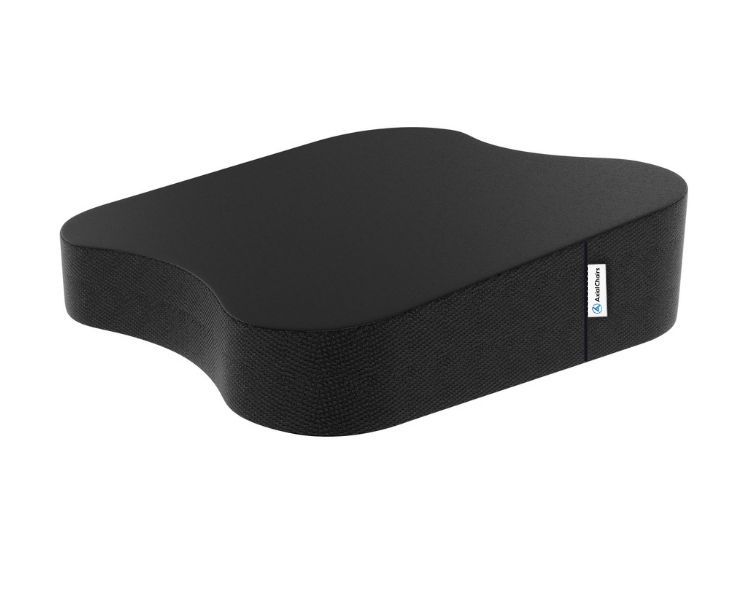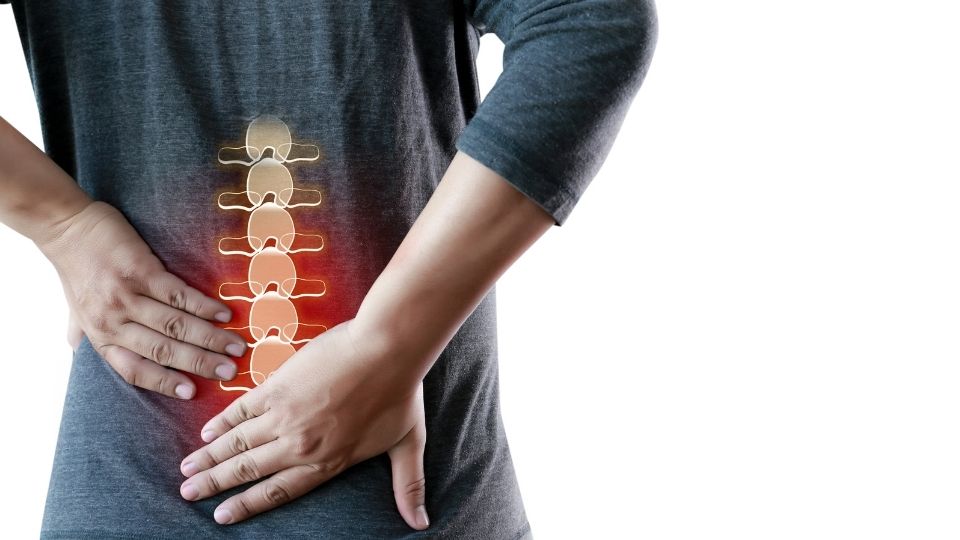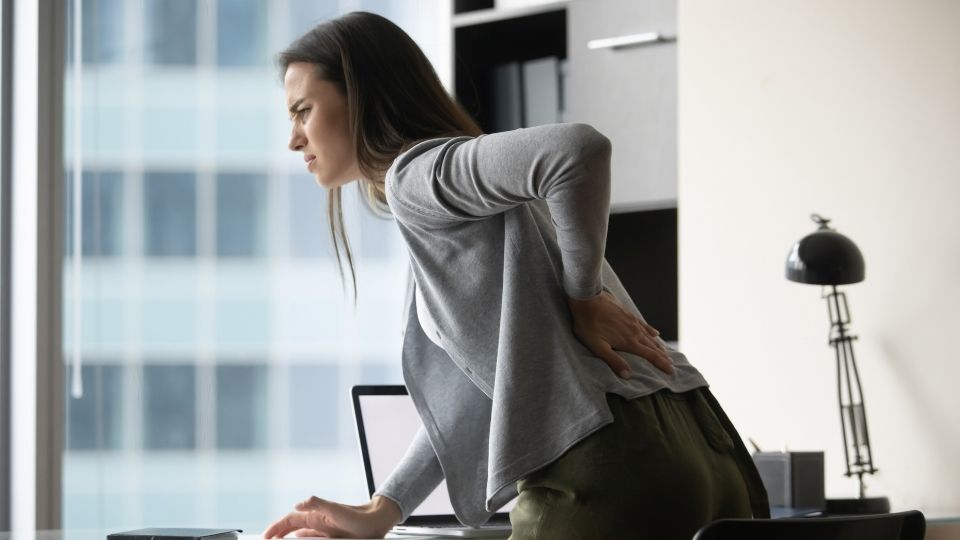Chiropractor Explains: How to Sit With a Herniated Disc
Suffering from a herniated disc can be a challenging experience, impacting your daily activities and overall quality of life. Proper sitting posture becomes crucial in managing the discomfort and promoting healing for individuals dealing with this condition. As a chiropractor and mattress designer with a comprehensive understanding of spinal alignment, muscle relaxation, comfort, and sustainability, I am here to provide you with expert guidance on how to sit with a herniated disc.
When it comes to sitting with a herniated disc, the primary goal is to minimize strain on the affected disc and surrounding structures. By adopting a supportive and ergonomically correct sitting posture, you can alleviate pain, reduce pressure on the spine, and encourage the healing process.
As a general rule, when sitting with a herniated disc, you should always keep your hips 5-10 cm above your knees and wear proper lumbar support to relieve pressure on your disks. If you have a herniated disk, you should reduce any pressure on it. Avoid sitting for long periods of over an hour.
*This is my opinion as a seat designer and chiropractor.
This article will tell you how to sit right based on my 30 years of experience treating herniated discs and working as an ergonomics specialist. I will give you some tips based on my book on avoiding low back pain while sitting and what to do if your back hurts. Following my simple recommendations in this blog, you will feel better and avoid back stiffness while sitting.
Here are some key considerations to keep in mind:
-
Choosing the right chair: Selecting an appropriate chair is paramount for individuals with a herniated disc. Opt for a chair that offers excellent lumbar support, preferably with an adjustable backrest and seat height. Look for chairs that promote proper spinal alignment, evenly distributing your body weight and minimizing pressure on the lower back.
-
Maintaining neutral spine alignment: When sitting with a herniated disc, it is crucial to maintain a neutral spine alignment to avoid exacerbating your symptoms. Start by positioning your hips all the way back into the chair, ensuring they are slightly higher than your knees. This position helps maintain the natural inward curve of your lower back, reducing stress on the discs.
-
Utilizing additional support: To further support your lower back, consider using a lumbar roll or cushion. These aids provide extra support and help maintain the natural curvature of your lumbar spine. Place the cushion or roll at the level of your lower back, ensuring it fits snugly against your spine. This additional support can alleviate pressure on the affected disc and provide relief.
-
Distributing weight evenly: When sitting, distribute your body weight evenly on both hips and avoid crossing your legs, as it can lead to imbalances and strain on the spine. Keep your feet flat on the floor or use a footrest to support your legs if needed. This approach helps maintain a stable base and reduces stress on the lower back.
-
Taking regular breaks: Prolonged sitting can worsen the symptoms of a herniated disc. It is essential to take regular breaks and incorporate movement into your daily routine. Stand up, stretch, and walk around for a few minutes every hour to promote blood circulation, relieve muscle tension, and reduce the load on your spinal discs.
Remember, these recommendations are general guidelines, and it is crucial to consult with a qualified healthcare professional or chiropractor for an individualized assessment and tailored advice based on your specific condition and needs. By implementing these sitting strategies and making adjustments to your work or home environment, you can manage your herniated disc more effectively and improve your overall well-being.
Best Seat Cushion for Back SupportDoctor's Recommendation
Black Friday Offer!
Get 35% off Orthopedic Seat Cushion
Product DetailsResearch-based Design
Recommended ForBack Discomfort
Video Guide
Video Guide
Is Sitting Bad for Herniated Disc?
The pain experienced by a person with a disc herniation may intensify with a lousy posture, and sitting can worsen it. Many things can exacerbate the pain experienced by a herniated disc, including sneezing, coughing, bending over and driving, etc.
How to Get a Seat Right for Herniated Disc
- Seat height. Get your seat up as high as feasible.
- Foot placement. Ensure both feet are on the ground with legs at least shoulder-width apart.
- Use lumbar support. You can use a small cushion or a rolled towel for lumbar support if your chair does not have one.
- Forward tilt. If you’re looking for a way to help relax your low back muscles, having your hips in an elevated position compared to your knees may be beneficial.
- Seat width. Slide your seat to the point that the space between your knees’ back and your chair’s edge is 2-3cm. The more surface that you sit on, the better you will feel. Replace your office chair if it doesn’t have this feature since it may have the most significant impact on reducing your sciatica pain while sitting.
- Monitor position. Ensure your monitor is at an arms-length distance and eye level. Monitors that are too low may increase disc pressure from leaning forward.
I explain the concept of my ergonomic design on a TV show HERE
Herniated Disc Can’t Sit
As a chiropractor, I have often encountered patients who struggle with sitting due to a herniated disc. The pain and discomfort can be quite debilitating, making it challenging for them to find a comfortable position. While I cannot provide personalized advice without a proper examination, there are some general recommendations that may help.
Firstly, it is crucial to avoid sitting for prolonged periods, as this can aggravate the condition. If sitting is necessary, using a chair with good lumbar support can help maintain proper spinal alignment and relieve some of the pressure on the herniated disc. Additionally, using a cushion or pillow to support the lower back may provide some relief.
It’s also important to maintain good posture while sitting. Sitting with a straight back and avoiding slouching can help distribute the weight evenly across the spine and reduce strain on the affected disc. Taking regular breaks to stretch and move around can also alleviate discomfort and prevent stiffness.
Remember, these suggestions are general in nature, and it’s always best to consult with a healthcare professional, such as a chiropractor or orthopedic specialist, who can provide a comprehensive evaluation and personalized recommendations based on your specific condition.
I’ve written a complete hands-on review about the best sitting position for sciatica, and here is what I tested best with my sciatica patients.
Best Way to Sit With L5-S1 Herniated Disc
As a chiropractor, I have treated many individuals with L5-S1 herniated discs, and finding the best sitting position for them can make a significant difference in managing their symptoms. While individual cases may vary, here are some general tips that may be helpful.
When sitting with an L5-S1 herniated disc, it’s crucial to maintain good posture and provide proper support to the lower back. Using a chair with ergonomic features, such as adjustable lumbar support and a cushioned seat, can help promote a neutral spine alignment.
All Day Comfort & Support
To achieve optimal sitting posture, ensure that your feet are planted firmly on the floor, your knees are at a right angle, and your back is straight. Avoid slouching or crossing your legs, as these positions can place additional stress on the affected disc.
It may also be beneficial to use a cushion or pillow to support the lower back’s natural curve and relieve some pressure on the disc. This additional support can help reduce discomfort and promote a more comfortable sitting experience.
Keep in mind that these suggestions are general in nature, and it’s always best to consult with a healthcare professional, such as a chiropractor or orthopedic specialist, who can assess your specific condition and provide tailored recommendations for sitting with an L5-S1 herniated disc.
How to Sleep With Herniated Disc and Sciatica
Sleeping with a herniated disc and sciatica can be challenging, as the pain and discomfort often worsen when lying down. As a chiropractor, I have assisted many patients in finding strategies to improve their sleep quality while managing these conditions. Here are some general tips that may be helpful:
-
Choose the right mattress: Opt for a medium-firm mattress that provides adequate support to the spine. A mattress that is too soft can cause the body to sink, misaligning the spine and exacerbating symptoms. Similarly, a mattress that is too firm may not provide enough cushioning. My personal favorite is natural latex!
-
Try different sleeping positions: Experiment with different sleeping positions to find the one that offers the most relief. For many individuals, sleeping on the back with a pillow under the knees can help maintain the natural curvature of the spine. Others find relief by sleeping on their side with a pillow between their legs to keep the spine aligned.
-
Use supportive pillows: Consider using pillows to support your body in a comfortable position. Placing a very thin pillow under the lower back or using a body pillow for added support can help alleviate pressure on the herniated disc and sciatic nerve.
Best Seat Cushion for Back SupportAxial Ergonomic Seat Cushion® | Seat Chair Wedge
Quick Guide: A 30-Second Summary
-
Practice good sleep hygiene: Establish a bedtime routine that promotes relaxation and quality sleep. Avoid stimulating activities, such as using electronic devices or consuming caffeine, close to bedtime. Create a calm and comfortable sleep environment, keeping the room dark, cool, and quiet.
-
Use heat or cold therapy: Applying heat or cold therapy to the affected area before bed can help alleviate pain and reduce inflammation. Some individuals find relief by using a heating pad or taking a warm bath, while others prefer using ice packs or cold compresses. Experiment to see which therapy works best for you.
-
Consider additional support: In some cases, using additional support devices can provide relief during sleep. For example, wearing a lumbar support belt or using a specialized pillow designed for spinal alignment may help reduce discomfort and improve sleep quality.
Remember, these recommendations are general in nature, and it’s important to consult with a healthcare professional, such as a chiropractor or orthopedic specialist, to receive personalized advice based on your specific condition. They can assess your symptoms and provide tailored recommendations to help you sleep better while managing a herniated disc and sciatica.
How to Get a Slipped Disc Back in Place
I often encounter patients seeking assistance in getting a slipped disc back in place. It’s important to note that a slipped disc, also known as a herniated or bulging disc, typically requires professional medical evaluation and treatment. However, I can provide some general insights into the process.
Getting a slipped disc back in place often involves a combination of non-invasive treatments, including chiropractic adjustments, physical therapy, and other conservative measures. Chiropractic adjustments aim to realign the spine and reduce pressure on the affected disc. These adjustments are performed by a trained chiropractor who applies controlled force to specific areas of the spine to restore proper alignment and alleviate symptoms.

All Day Comfort & Support
Product Name
Axial Designs™ Seat Cushion
Price
$149
Warranty
1 Year
Type
Posture Wedge
Top Layer
100% Natural Latex (Molded)
Bottom Layer
High-Density Foam
Top Material
Isometric Grippy Vegan Leather
Bottom Material
Non-Slip Material
Side Material
3D Breathable Fabric
Physical therapy exercises, such as stretching and strengthening exercises, can also be beneficial in supporting the spine, improving flexibility, and reducing pain associated with a slipped disc. Your chiropractor or physical therapist can guide you through a personalized exercise program tailored to your needs.
Additionally, other modalities like heat therapy, ice therapy, and electrical stimulation may be utilized to reduce inflammation, alleviate pain, and promote healing.
It’s important to emphasize that attempting to “pop” or manipulate your spine at home can be dangerous and should be avoided. Self-treatment without professional guidance can potentially worsen your condition or lead to complications.
If you suspect you have a slipped disc or are experiencing symptoms such as back pain, radiating leg pain, numbness, or weakness, it’s crucial to consult with a healthcare professional, such as a chiropractor or orthopedic specialist. They can assess your condition, provide a proper diagnosis, and recommend an appropriate treatment plan to help get your slipped disc back in place safely and effectively.
How to Heal a Herniated Disc Quickly
In my practice, I understand the desire to heal a herniated disc quickly and alleviate the associated pain and discomfort. However, it’s important to note that the healing process for a herniated disc varies from person to person, and there is no guaranteed quick fix. Healing often requires a combination of time, appropriate treatment, and lifestyle modifications. Here are some general tips that may aid in the healing process:
-
Seek professional guidance: Consult with a healthcare professional, such as a chiropractor or orthopedic specialist, who can evaluate your condition and provide a personalized treatment plan. They may recommend a combination of therapies, such as chiropractic adjustments, physical therapy, pain management techniques, and lifestyle modifications, to promote healing.
-
Follow a conservative approach: Initially, non-invasive and conservative treatments are often recommended for herniated disc healing. These may include rest, avoiding activities that exacerbate symptoms, using hot or cold therapy to reduce inflammation, and taking over-the-counter pain medications as advised by your healthcare professional.
Black Friday: 35% Off Today
Typical Delivery 1-3 Days
-
Physical therapy: Engaging in a targeted physical therapy program can help strengthen the muscles supporting the spine, improve flexibility, and promote proper posture. A physical therapist can guide you through exercises and techniques that are safe and appropriate for your condition.
-
Chiropractic care: Chiropractic adjustments can be beneficial in realigning the spine, relieving pressure on the herniated disc, and facilitating the healing process. A chiropractor will use specialized techniques to gently manipulate the spine and promote proper spinal alignment. A good choice to consider is non-surgical spinal decompression. Check to see if your local chiropractor offers this service.
-
Patience and self-care: Healing a herniated disc takes time and patience. It’s important to listen to your body and avoid activities that worsen your symptoms. Incorporate stress-reducing techniques, such as meditation or deep breathing exercises, to manage pain and promote overall well-being during the healing process.
It’s essential to note that these recommendations are general in nature and may not be suitable for everyone. Each individual’s condition is unique, and it’s best to consult with a healthcare professional, such as a chiropractor or orthopedic specialist, to receive personalized advice and a tailored treatment plan for healing a herniated disc. They can assess your specific condition and provide guidance based on your needs.
Sitting in a Car With a Herniated Disc
Traveling while suffering from a herniated disc may be painful, but there are ways to minimize the discomfort. Here are a few tips:
- Get your car seat in the highest position possible.
- Bring your car seat back as far as (safely) possible.
- Stabilize your back by sitting with good posture. Some people find that using a rolled-up towel between your back and the affected area when driving is beneficial.
- While driving, you can also sit on a pillow or cushion to relieve the strain on the back.
- Speak to a doctor about the precautions you can take to limit the pressure on a herniated disc while driving.
What You Should Not Do With a Herniated Disc
The pain in your lower back from a herniated disc can be mild or debilitating but most often radiates to your leg. Although herniated discs gradually become less painful after a few weeks, many everyday activities can aggravate them.
Avoid the Following with Herniated Disc:
- Long periods of sitting. Your lower back suffers more when you sit down, especially when you slouch forward while sitting.
- Flexion or compressive exercises. While exercise is still important, it’s best to avoid intense movements that increase the pressure on your spinal discs, especially exercises in which you bend forward (flexion).
- Gardening. Mowing your lawn, raking leaves, and excessive bending can worsen your disc pain, as it often involves putting too much rotation and pressure on your discs.
- Vacuuming or Hoovering. Herniated discs are easily irritated by the repetitive motion of vacuuming.
Black Friday: 35% Off Today
Typical Delivery 1-3 Days
Fastest Way to Heal a Herniated Disc
- Get your sleep right. Various sleep positions can ease the pain of a herniated disc. As you likely know, lumbar herniated discs cause pain that can worsen during sleep.
How To Relieve Pressure on Your Spine When Sleeping:
- Mattress. Use a medium-firm (preferably natural latex) mattress.
- Back sleeping. Under your knees, you can insert a pillow to reduce back tension.
- Side sleeping. Put a pillow between your knees while sleeping on your side to prevent your spine from sagging too far and keep your hips balanced.
- Alternating heat and ice. You can relieve immediate sciatic nerve pain by alternately applying heat and ice. Ice can help reduce swelling, while heat can help speed healing. Both heat and ice may also help ease painful muscle spasms that often accompany sciatica.
- Non-Surgical Spinal Decompression. This therapy is a fancy name for mechanical traction. However, I feel this is better than traction because this therapy incorporates perpetual movement.
- Chiropractic care. Sciatica can also be treated effectively with the help of a good chiropractor.
All Day Comfort & Support
Is Walking Good for Herniated Disc?
Walking Benefits for Herniated Disc
- It increases blood flow. Exercise helps increase blood flow through the muscles, improving their supply of oxygen and nutrients.
- Rids toxins. Walking helps flush out these toxins and improve flexibility.
- Improves low back flexibility. Lack of physical inactivity can cause your back and hips to become stiff.
How Long Does Sciatica Pain From a Herniated Disc Last?
In my experience, most patients affected by acute sciatica will start to recover within two to three weeks. However, some patients may develop chronic sciatica pain sporadically for several years, especially if the causative factor is a herniated disc.
Getting an MRI scan and a proper diagnosis is always a good idea. Please seek medical attention immediately if you experience sciatica symptoms longer than a week or if you have either bladder control or bowel control problems.
What Happens If a Herniated Disc Goes Untreated?
You shouldn’t ignore sciatic pain. Left untreated, a herniated disc can permanently damage the disc, facet joints, and nerves. There are extremely rare cases where a disc rupture can cause you to lose bladder or bowel control, and the supply of signals to the leg can also be cut off.
I think getting an MRI is always a good idea if you don’t feel better after staying with your sciatic pain for an extended period. Knowing is better than guessing, in my opinion.
Is Rest Good for Herniated Disc?
Typically, a doctor will advise two to seven days of rest after a herniated disk. If you have lower back pain or sciatica, you probably need to avoid over-resting and stay as active as possible. Strengthening the spinal column with gentle activities and exercises will help reduce pressure on the spinal column.
[Black Friday: 35% Off Today
Typical Delivery 1-3 Days
Sitting With Lumbar Support
Sitting can be difficult for those dealing with a herniated disc, as without the right position the pain and discomfort can worsen. Fortunately, there are steps that can be taken to make it more comfortable. For instance, using lumbar support to prop up your lower back can take pressure away from your spine and help ease the pain. Additionally, improving your posture by keeping your back straight and shoulders pulled back is a great way to decrease any suffering caused by sitting for extended periods.
These strategies may help minimize discomfort felt while sitting and make it easier to complete everyday tasks. It is important to note that even following these suggestions does not guarantee relief from the symptoms of a herniated disc – it may still be necessary to seek medical advice if you find yourself struggling with consistent pain or discomfort when seated.
However, for those looking for ways to manage their condition, taking advantage of lumbar support and a well-designed ergonomic seat cushion may offer some respite from their symptoms while they continue on their road to recovery.
Conclusion
I’ve worked with countless people who suffered from herniated discs, all of whom spent significant time sitting at the employment. To avoid the potential dangers of sitting with a herniated disc, I strongly advise you to consider the advice I imparted today. You should enjoy long-lasting beneficial effects by implementing these simple changes to your sitting environment.
Numerous other factors may cause lower back problems, as well. That’s why it is always a good idea to diagnose your situation correctly.
Lastly, remember that unconscious and complacent movements will eventually make you break down. If you stay active and conscious throughout your day, your low back pain may disappear.
Sources:
- Wilder, D.G., Pope, M.H. and Frymoyer, J.W., 1988. The biomechanics of lumbar disc herniation and the effect of overload and instability. Journal of spinal disorders, 1(1), pp.16-32.
- KELSEY, J.L., 1975. An epidemiological study of the relationship between occupations and acute herniated lumbar intervertebral discs. International Journal of Epidemiology, 4(3), pp.197-205.
- Harrison, D.D., Harrison, S.O., Croft, A.C., Harrison, D.E. and Troyanovich, S.J., 2000. Sitting biomechanics, part II: optimal car driver’s seat and optimal driver’s spinal model. Journal of manipulative and physiological therapeutics, 23(1), pp.37-47.
- Olmarker, K., Iwabuchi, M., Larsson, K. and Rydevik, B., 1998. Walking analysis of rats subjected to experimental disc herniation. European Spine Journal, 7(5), pp.394-399.
- Belavý, D.L., Bansmann, P.M., Böhme, G., Frings-Meuthen, P., Heer, M., Rittweger, J., Zange, J. and Felsenberg, D., 2011. Changes in intervertebral disc morphology persist 5 mo after 21-day bed rest. Journal of applied physiology, 111(5), pp.1304-1314.










